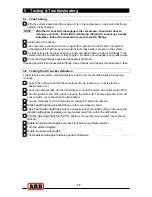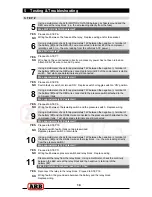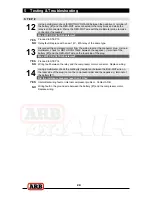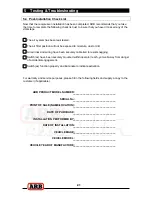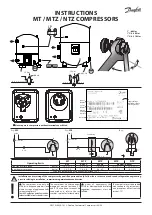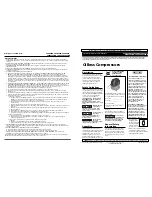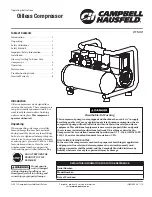
5 Testing & Troubleshooting
17
5.1 Leak Testing
F
With the vehicle parked and the engine off, turn the compressor on and wait until the air
system is fully charged.
NOTE : With the Air Locker(s) disengaged, the compressor should not have to
recharge over time. Intermittent recharging without Air Locker use usually
indicates a leak at the solenoid or pressure switch fittings.
F
Actuate the
Air Locker
(s).
F
The compressor should not come on again for a period of at least 15min. Air system
recharging within that time period would indicate that a leak is present in the system.
F
If a leak is found to be present, spray a soap and water mixture onto all air fittings in the
system while the compressor is fully charged. Bubbles should appear at any leak points.
F
Check that leaky fittings have been adequately tightened.
If leaking persists then disassemble fittings, clean threads, and reapply thread sealant / tape.
5.2 Testing the Air Locker Actuation
To test that the air system, electrical system, and the
Air Locker
differential is functioning
correctly:
F
Support the vehicle such that the wheels are free to rotate (e.g., on axle stands, a
chassis hoist, etc.)
F
Leave the parking brake off, the transmission in neutral, and the
Air Locker
switch ‘OFF’.
F
Turn the ignition to the ‘ON’ position (leaving the motor off). The large symbol on the
Air
Locker
switch cover should not be illuminated.
F
Turn the compressor on to charge the air supply to maximum pressure.
F
While supporting the drive shaft flange, rotate one wheel by hand.
F
The wheel should rotate freely and the opposite wheel should be turning in the opposite
direction without any resistance or mechanical noise from within the differential.
F
Turn the
Air Locker
switch to the ‘ON’ position. The symbol on the switch cover should
light up.
F
Rotate the same wheel again and check that both wheel rotate together.
F
Turn the switch off again.
F
Rotate the same wheel again.
F
The wheels should again rotate in opposite directions.















